The Deception of Evolution
Darwinism, in other words the theory of evolution, was put forward with the aim of denying the fact of creation, but is in truth nothing but failed, unscientific nonsense. This theory, which claims that life emerged by chance from inanimate matter, was invalidated by the scientific evidence of clear "design" in the universe and in living things. In this way, science confirmed the fact that Allah created the universe and the living things in it. The propaganda carried out today in order to keep the theory of evolution alive is based solely on the distortion of the scientific facts, biased interpretation, and lies and falsehoods disguised as science.
Yet this propaganda cannot conceal the truth. The fact that the theory of evolution is the greatest deception in the history of science has been expressed more and more in the scientific world over the last 20-30 years. Research carried out after the 1980s in particular has revealed that the claims of Darwinism are totally unfounded, something that has been stated by a large number of scientists. In the United States in particular, many scientists from such different fields as biology, biochemistry and paleontology recognize the invalidity of Darwinism and employ the concept of intelligent design to account for the origin of life. This "intelligent design" is a scientific expression of the fact that Allah created all living things.
We have examined the collapse of the theory of evolution and the proofs of creation in great scientific detail in many of our works, and are still continuing to do so. Given the enormous importance of this subject, it will be of great benefit to summarize it here.
 |
The Scientific Collapse of Darwinism
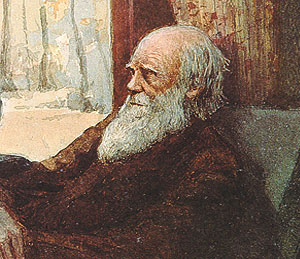 |
Charles Darwin |
Although this doctrine goes back as far as ancient Greece, the theory of evolution was advanced extensively in the nineteenth century. The most important development that made it the top topic of the world of science was Charles Darwin's The Origin of Speciespublished in 1859. In this book, he denied that Allah created different living species on Earth separately, for he claimed that all living beings had a common ancestor and had diversified over time through small changes. Darwin's theory was not based on any concrete scientific finding; as he also accepted, it was just an "assumption." Moreover, as Darwin confessed in the long chapter of his book titled "Difficulties of the Theory," the theory failed in the face of many critical questions.
Darwin invested all of his hopes in new scientific discoveries, which he expected to solve these difficulties. However, contrary to his expectations, scientific findings expanded the dimensions of these difficulties. The defeat of Darwinism in the face of science can be reviewed under three basic topics:
1) The theory cannot explain how life originated on Earth.
2) No scientific finding shows that the "evolutionary mechanisms" proposed by the theory have any evolutionary power at all.
3) The fossil record proves the exact opposite of what the theory suggests.
In this section, we will examine these three basic points in general outlines:
The First Insurmountable Step: The Origin of Life
The theory of evolution posits that all living species evolved from a single living cell that emerged on the primitive Earth 3.8 billion years ago. How a single cell could generate millions of complex living species and, if such an evolution really occurred, why traces of it cannot be observed in the fossil record are some of the questions that the theory cannot answer. However, first and foremost, we need to ask: How did this "first cell" originate?
Since the theory of evolution denies creation and any kind of supernatural intervention, it maintains that the "first cell" originated coincidentally within the laws of nature, without any design, plan or arrangement. According to the theory, inanimate matter must have produced a living cell as a result of coincidences. Such a claim, however, is inconsistent with the most unassailable rules of biology.
"Life Comes from Life"
 |
Louise Pasteur |
In his book, Darwin never referred to the origin of life. The primitive understanding of science in his time rested on the assumption that living beings had a very simple structure. Since medieval times, spontaneous generation, which asserts that non-living materials came together to form living organisms, had been widely accepted. It was commonly believed that insects came into being from food leftovers, and mice from wheat. Interesting experiments were conducted to prove this theory. Some wheat was placed on a dirty piece of cloth, and it was believed that mice would originate from it after a while.
Similarly, maggots developing in rotting meat was assumed to be evidence of spontaneous generation. However, it was later understood that worms did not appear on meat spontaneously, but were carried there by flies in the form of larvae, invisible to the naked eye.
Even when Darwin wrote The Origin of Species, , the belief that bacteria could come into existence from non-living matter was widely accepted in the world of science.
However, five years after the publication of Darwin's book, Louis Pasteur announced his results after long studies and experiments, that disproved spontaneous generation, a cornerstone of Darwin's theory. In his triumphal lecture at the Sorbonne in 1864, Pasteur said: "Never will the doctrine of spontaneous generation recover from the mortal blow struck by this simple experiment."1
For a long time, advocates of the theory of evolution resisted these findings. However, as the development of science unraveled the complex structure of the cell of a living being, the idea that life could come into being coincidentally faced an even greater impasse.
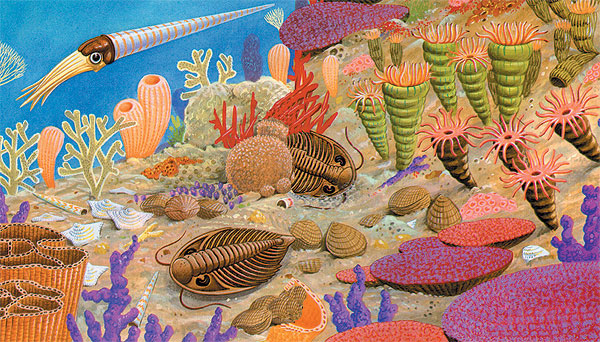 |
Inconclusive Efforts in the Twentieth Century
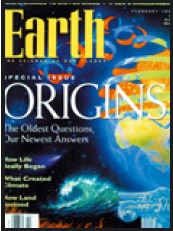 |
As accepted also by the latest evolutionist theorists, the origin of life is still a great stumbling block for the theory of evolution. |
The first evolutionist who took up the subject of the origin of life in the twentieth century was the renowned Russian biologist Alexander Oparin. With various theses he advanced in the 1930s, he tried to prove that a living cell could originate by coincidence. These studies, however, were doomed to failure, and Oparin had to make the following confession: Unfortunately, however, the problem of the origin of the cell is perhaps the most obscure point in the whole study of the evolution of organisms.2
Evolutionist followers of Oparin tried to carry out experiments to solve this problem. The best known experiment was carried out by the American chemist Stanley Miller in 1953. Combining the gases he alleged to have existed in the primordial Earth's atmosphere in an experiment set-up, and adding energy to the mixture, Miller synthesized several organic molecules (amino acids) present in the structure of proteins.
Barely a few years had passed before it was revealed that this experiment, which was then presented as an important step in the name of evolution, was invalid, for the atmosphere used in the experiment was very different from the real Earth conditions.3
After a long silence, Miller confessed that the atmosphere medium he used was unrealistic.4
All the evolutionists' efforts throughout the twentieth century to explain the origin of life ended in failure. The geochemist Jeffrey Bada, from the San Diego Scripps Institute accepts this fact in an article published in Earth magazine in 1998:
Today as we leave the twentieth century, we still face the biggest unsolved problem that we had when we entered the twentieth century: How did life originate on Earth?5
The Complex Structure of Life
 |
One of the facts nullifying the theory of evolution is the astonishingly complex structure of life. The DNA molecule located in the nucleus of cells of living beings is an example of this. The DNA is a sort of databank formed of the arrangement of four different molecules in different sequences. This databank contains the codes of all the physical traits of that living being. When the human DNA is put into writing, it is calculated that this would result in an encyclopedia made up of 900 volumes. Unquestionably, such extraordinary information definitively refutes the concept of coincidence. |
The primary reason why the theory of evolution ended up in such a great impasse regarding the origin of life is that even those living organisms deemed to be the simplest have incredibly complex structures. The cell of a living thing is more complex than all of our man-made technological products. Today, even in the most developed laboratories of the world, a living cell cannot be produced by bringing organic chemicals together.
The conditions required for the formation of a cell are too great in quantity to be explained away by coincidences. The probability of proteins, the building blocks of a cell, being synthesized coincidentally, is 1 in 10950 for an average protein made up of 500 amino acids. In mathematics, a probability smaller than 1 over 1050 is considered to be impossible in practical terms.
The DNA molecule, which is located in the nucleus of a cell and which stores genetic information, is an incredible databank. If the information coded in DNA were written down, it would make a giant library consisting of an estimated 900 volumes of encyclopedias consisting of 500 pages each.
 |
Alexander Oparin's attempts to offer an evolutionist explanation for the origin of life ended in a great fiasco. |
A very interesting dilemma emerges at this point: DNA can replicate itself only with the help of some specialized proteins (enzymes). However, the synthesis of these enzymes can be realized only by the information coded in DNA. As they both depend on each other, they have to exist at the same time for replication. This brings the scenario that life originated by itself to a deadlock. Prof. Leslie Orgel, an evolutionist of repute from the University of San Diego, California, confesses this fact in the September 1994 issue of the Scientific American magazine:
It is extremely improbable that proteins and nucleic acids, both of which are structurally complex, arose spontaneously in the same place at the same time. Yet it also seems impossible to have one without the other. And so, at first glance, one might have to conclude that life could never, in fact, have originated by chemical means.6
No doubt, if it is impossible for life to have originated from natural causes, then it has to be accepted that life was "created" in a supernatural way. This fact explicitly invalidates the theory of evolution, whose main purpose is to deny creation.
Imaginary Mechanism of Evolution
The second important point that negates Darwin's theory is that both concepts put forward by the theory as "evolutionary mechanisms" were understood to have, in reality, no evolutionary power.
Darwin based his evolution allegation entirely on the mechanism of "natural selection." The importance he placed on this mechanism was evident in the name of his book: The Origin of Species, By Means of Natural Selection…
Natural selection holds that those living things that are stronger and more suited to the natural conditions of their habitats will survive in the struggle for life. For example, in a deer herd under the threat of attack by wild animals, those that can run faster will survive. Therefore, the deer herd will be comprised of faster and stronger individuals. However, unquestionably, this mechanism will not cause deer to evolve and transform themselves into another living species, for instance, horses.
Therefore, the mechanism of natural selection has no evolutionary power. Darwin was also aware of this fact and had to state this in his book The Origin of Species:
Natural selection can do nothing until favourable individual differences or variations occur.7
Lamarck's Impact
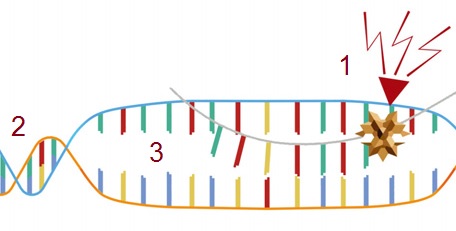 |
So, how could these "favorable variations" occur? Darwin tried to answer this question from the standpoint of the primitive understanding of science at that time. According to the French biologist Chevalier de Lamarck (1744-1829), who lived before Darwin, living creatures passed on the traits they acquired during their lifetime to the next generation. He asserted that these traits, which accumulated from one generation to another, caused new species to be formed. For instance, he claimed that giraffes evolved from antelopes; as they struggled to eat the leaves of high trees, their necks were extended from generation to generation.
Doğal Seleksiyonu doğrulayan tek bir delil dahi bulunmamaktadır.
Doğal seleksiyona göre, güçlü olan ve yaşadığı çevreye uyum sağlayabilen canlılar hayatta kalır, diğerleri ise yok olurlar. Evrimciler ise doğal seleksiyonun canlıları evrimleştirdiğini, yeni türler meydana getirdiğini öne sürerler. Oysa doğal seleksiyonun böyle bir sonucu yoktur ve bu iddiayı doğrulayan tek bir delil dahi bulunmamaktadır.
Darwin also gave similar examples. In his book The Origin of Species, for instance, he said that some bears going into water to find food transformed themselves into whales over time.8
However, the laws of inheritance discovered by Gregor Mendel (1822-84) and verified by the science of genetics, which flourished in the twentieth century, utterly demolished the legend that acquired traits were passed on to subsequent generations. Thus, natural selection fell out of favor as an evolutionary mechanism.
 |
Natural selection only selects out the disfigured, weak, or unfit individuals of a species. It cannot produce new species, new genetic information, or new organs. |
Neo-Darwinism and Mutations
 |
In order to find a solution, Darwinists advanced the "Modern Synthetic Theory," or as it is more commonly known, Neo-Darwinism, at the end of the 1930's. Neo-Darwinism added mutations, which are distortions formed in the genes of living beings due to such external factors as radiation or replication errors, as the "cause of favorable variations" in addition to natural mutation.
Today, the model that stands for evolution in the world is Neo-Darwinism. The theory maintains that millions of living beings formed as a result of a process whereby numerous complex organs of these organisms (e.g., ears, eyes, lungs, and wings) underwent "mutations," that is, genetic disorders. Yet, there is an outright scientific fact that totally undermines this theory: Mutations do not cause living beings to develop; on the contrary, they are always harmful.
The reason for this is very simple: DNA has a very complex structure, and random effects can only harm it. The American geneticist B.G. Ranganathan explains this as follows:
First, genuine mutations are very rare in nature. Secondly, most mutations are harmful since they are random, rather than orderly changes in the structure of genes; any random change in a highly ordered system will be for the worse, not for the better. For example, if an earthquake were to shake a highly ordered structure such as a building, there would be a random change in the framework of the building which, in all probability, would not be an improvement.9
Not surprisingly, no mutation example, which is useful, that is, which is observed to develop the genetic code, has been observed so far. All mutations have proved to be harmful. It was understood that mutation, which is presented as an "evolutionary mechanism," is actually a genetic occurrence that harms living things, and leaves them disabled. (The most common effect of mutation on human beings is cancer.) Of course, a destructive mechanism cannot be an "evolutionary mechanism." Natural selection, on the other hand, "can do nothing by itself," as Darwin also accepted. This fact shows us that there is no "evolutionary mechanism" in nature. Since no evolutionary mechanism exists, no such any imaginary process called "evolution" could have taken place.
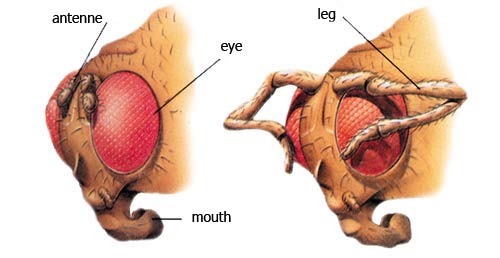 | |
1. Antenne | 3. Eye |
Sinds het begin van de twintigste eeuw hebben evolutionaire biologen naar voorbeelden van gunstige mutaties gezocht door het creëren van mutant vliegen. Maar deze inspanningen hebben altijd geleid tot zieke en misvormde wezens. De foto links toont het hoofd van een normale fruitvlieg en de foto rechts toont het hoofd van een fruitvlieg waar de poten uitkomen, wat het resultaat van de mutatie is. | |
The Fossil Record: No Sign of Intermediate Forms
The clearest evidence that the scenario suggested by the theory of evolution did not take place is the fossil record.
According to this theory, every living species has sprung from a predecessor. A previously existing species turned into something else over time and all species have come into being in this way. In other words, this transformation proceeds gradually over millions of years.
Had this been the case, numerous intermediary species should have existed and lived within this long transformation period.
For instance, some half-fish/half-reptiles should have lived in the past which had acquired some reptilian traits in addition to the fish traits they already had. Or there should have existed some reptile-birds, which acquired some bird traits in addition to the reptilian traits they already had. Since these would be in a transitional phase, they should be disabled, defective, crippled living beings. Evolutionists refer to these imaginary creatures, which they believe to have lived in the past, as "transitional forms."
If such animals ever really existed, there should be millions and even billions of them in number and variety. More importantly, the remains of these strange creatures should be present in the fossil record.In The Origin of Species, Darwin explained:
If my theory be true, numberless intermediate varieties, linking most closely all of the species of the same group together must assuredly have existed... Consequently, evidence of their former existence could be found only amongst fossil remains.10
Living Fossils Refute Evolution |
Fossils are proof that evolution never happened. As the fossil record reveals, living things suddenly appeared together with all the characteristics they possess, and they never undergo the slightest change so long as they remain in existence. Fish have always existed as fish, insects as insects, and reptiles as reptiles. There is no scientific validity to the claim that species emerged gradually. |
 |
Crane Fly Period: Cenozoic Age, Eocene Period |
 |
Sea Urchin Period: Paleozoic Age, Carboniferous Period |
 |
Sun Fish Period: Cenozoic Age, Eocene Period |
 |
Birch Tree Leaf Period: Cenozoic Age, Eocene Period |
 |
Sequoia Leaf Period: Cenozoic Age, Eocene Period |
 |
Starfish Period: Paleozoic Age, Ordovician Period |
 |
Cicada |
Darwin's Hopes Shattered
However, although evolutionists have been making strenuous efforts to find fossils since the middle of the nineteenth century all over the world, no transitional forms have yet been uncovered. All of the fossils, contrary to the evolutionists' expectations, show that life appeared on Earth all of a sudden and fully-formed.
One famous British paleontologist, Derek V. Ager, admits this fact, even though he is an evolutionist:
The point emerges that if we examine the fossil record in detail, whether at the level of orders or of species, we find—over and over again—not gradual evolution, but the sudden explosion of one group at the expense of another.11
This means that in the fossil record, all living species suddenly emerge as fully formed, without any intermediate forms in between. This is just the opposite of Darwin's assumptions. Also, this is very strong evidence that all living things are created. The only explanation of a living species emerging suddenly and complete in every detail without any evolutionary ancestor is that it was created. This fact is admitted also by the widely known evolutionist biologist Douglas Futuyma:
Creation and evolution, between them, exhaust the possible explanations for the origin of living things. Organisms either appeared on the earth fully developed or they did not. If they did not, they must have developed from pre-existing species by some process of modification. If they did appear in a fully developed state, they must indeed have been created by some omnipotent intelligence.12
Fossils show that living beings emerged fully developed and in a perfect state on the Earth. That means that "the origin of species," contrary to Darwin's supposition, is not evolution, but creation.
The Tale of Human Evolution
Evrimciler, fosiller üzerinde genelde ideolojik beklentileri doğrultusunda şekillendirdikleri yorumlar yaparlar. Bu nedenle vardıkları sonuçlar güvenilir değildir.
Evrimciler, fosiller üzerinde genelde ideolojik beklentileri doğrultusunda şekillendirdikleri yorumlar yaparlar. Bu nedenle vardıkları sonuçlar güvenilir değildir.
The subject most often brought up by advocates of the theory of evolution is the subject of the origin of man. The Darwinist claim holds that modern man evolved from ape-like creatures. During this alleged evolutionary process, which is supposed to have started 4-5 million years ago, some "transitional forms" between modern man and his ancestors are supposed to have existed. According to this completely imaginary scenario, four basic "categories" are listed:
1. Australopithecus
2. Homo habilis
3) Homo erectus
4) Homo sapiens
Evolutionists call man's so-called first ape-like ancestors Australopithecus, which means "South African ape." These living beings are actually nothing but an old ape species that has become extinct. Extensive research done on various Australopithecus specimens by two world famous anatomists from England and the USA, namely, Lord Solly Zuckerman and Prof. Charles Oxnard, shows that these apes belonged to an ordinary ape species that became extinct and bore no resemblance to humans.13
Evolutionists classify the next stage of human evolution as "homo," that is "man." According to their claim, the living beings in the Homo series are more developed than Australopithecus. Evolutionists devise a fanciful evolution scheme by arranging different fossils of these creatures in a particular order. This scheme is imaginary because it has never been proved that there is an evolutionary relation between these different classes. Ernst Mayr, one of the twentieth century's most important evolutionists, contends in his book One Long Argument that "particularly historical [puzzles] such as the origin of life or of Homo sapiens, are extremely difficult and may even resist a final, satisfying explanation."14
By outlining the link chain as Australopithecus > Homo habilis > Homo erectus > Homo sapiens, evolutionists imply that each of these species is one another's ancestor. However, recent findings of paleoanthropologists have revealed that Australopithecus, Homo habilis, and Homo erectus lived at different parts of the world at the same time.15
 |
SAHTE = FALSE |
There are no fossil remains that support the tale of human evolution. On the contrary, the fossil record shows that there is an insurmountable barrier between apes and men. In the face of this truth, evolutionists fixed their hopes on certain drawings and models. They randomly place masks on the fossil remains and fabricate imaginary half-ape, half-human faces. |
Moreover, a certain segment of humans classified as Homo erectus have lived up until very modern times. Homo sapiens neandarthalensis and Homo sapiens sapiens (modern man) co-existed in the same region.16
This situation apparently indicates the invalidity of the claim that they are ancestors of one another. A paleontologist from Harvard University, Stephen Jay Gould, explains this deadlock of the theory of evolution, although he is an evolutionist himself:
What has become of our ladder if there are three coexisting lineages of hominids (A. africanus, the robust australopithecines, and H. habilis), none clearly derived from another? Moreover, none of the three display any evolutionary trends during their tenure on earth.17
Put briefly, the scenario of human evolution, which is "upheld" with the help of various drawings of some "half ape, half human" creatures appearing in the media and course books, that is, frankly, by means of propaganda, is nothing but a tale with no scientific foundation.
Lord Solly Zuckerman, one of the most famous and respected scientists in the U.K., who carried out research on this subject for years and studied Australopithecus fossils for 15 years, finally concluded, despite being an evolutionist himself, that there is, in fact, no such family tree branching out from ape-like creatures to man.
Zuckerman also made an interesting "spectrum of science" ranging from those he considered scientific to those he considered unscientific. According to Zuckerman's spectrum, the most "scientific"—that is, depending on concrete data—fields of science are chemistry and physics. After them come the biological sciences and then the social sciences. At the far end of the spectrum, which is the part considered to be most "unscientific," are "extra-sensory perception"—concepts such as telepathy and sixth sense—and finally "human evolution." Zuckerman explains his reasoning:
We then move right off the register of objective truth into those fields of presumed biological science, like extrasensory perception or the interpretation of man's fossil history, where to the faithful [evolutionist] anything is possible—and where the ardent believer [in evolution] is sometimes able to believe several contradictory things at the same time.18
The tale of human evolution boils down to nothing but the prejudiced interpretations of some fossils unearthed by certain people, who blindly adhere to their theory.
Darwinian Formula!
 |
Can life emerge if all the conditions stipulated by evolutionists are met? Of course not! In order to show why not, let us carry out the following experiment: Place all the enzymes, hormones and proteins—everything that evolutionists regard as essential for life to form—into a barrel such as that pictured on the left page. Then mix all these substances, using all possible physical and chemical techniques. But whatever you do, no matter how long you wait, not a single living cell will emerge from that barrel. |
Besides all the technical evidence we have dealt with so far, let us now for once, examine what kind of a superstition the evolutionists have with an example so simple as to be understood even by children:
The theory of evolution asserts that life is formed by chance. According to this claim, lifeless and unconscious atoms came together to form the cell and then they somehow formed other living things, including man. Let us think about that. When we bring together the elements that are the building-blocks of life such as carbon, phosphorus, nitrogen and potassium, only a heap is formed. No matter what treatments it undergoes, this atomic heap cannot form even a single living being. If you like, let us formulate an "experiment" on this subject and let us examine on the behalf of evolutionists what they really claim without pronouncing loudly under the name "Darwinian formula":
Let evolutionists put plenty of materials present in the composition of living things such as phosphorus, nitrogen, carbon, oxygen, iron, and magnesium into big barrels. Moreover, let them add in these barrels any material that does not exist under normal conditions, but they think as necessary. Let them add in this mixture as many amino acids—which have no possibility of forming under natural conditions—and as many proteins—a single one of which has a formation probability of 10-950—as they like. Let them expose these mixtures to as much heat and moisture as they like. Let them stir these with whatever technologically developed device they like. Let them put the foremost scientists beside these barrels. Let these experts wait in turn beside these barrels for billions, and even trillions of years. Let them be free to use all kinds of conditions they believe to be necessary for a human's formation. No matter what they do, they cannot produce from these barrels a human, say a professor that examines his cell structure under the electron microscope. They cannot produce giraffes, lions, bees, canaries, horses, dolphins, roses, orchids, lilies, carnations, bananas, oranges, apples, dates, tomatoes, melons, watermelons, figs, olives, grapes, peaches, peafowls, pheasants, multicoloured butterflies, or millions of other living beings such as these. Indeed, they could not obtain even a single cell of any one of them.
Briefly, unconscious atoms cannot form the cell by coming together. They cannot take a new decision and divide this cell into two, then take other decisions and create the professors who first invent the electron microscope and then examine their own cell structure under that microscope. Matter is an unconscious, lifeless heap, and it comes to life with Allah's superior creation.
The theory of evolution, which claims the opposite, is a total fallacy completely contrary to reason. Thinking even a little bit on the claims of tevolutionists discloses this reality, just as in the above example.
Technology in the Eye and the Ear
Another subject that remains unanswered by evolutionary theory is the excellent quality of perception in the eye and the ear.
 |
Compared to cameras and sound recording devices, the eye and ear are much more complex, much more successful and possess far superior features to these products of high technology. |
Before passing on to the subject of the eye, let us briefly answer the question of how we see. Light rays coming from an object fall oppositely on the eye's retina. Here, these light rays are transmitted into electric signals by cells and reach a tiny spot at the back of the brain, the "center of vision." These electric signals are perceived in this center as an image after a series of processes. With this technical background, let us do some thinking.
The brain is insulated from light. That means that its inside is completely dark, and that no light reaches the place where it is located. Thus, the "center of vision" is never touched by light and may even be the darkest place you have ever known. However, you observe a luminous, bright world in this pitch darkness.
Uzun yıllardır on binlerce mühendis üç boyutlu TV yapmaya, gözün görme kalitesine ulaşmaya çalışmaktadırlar. Evet, üç boyutlu bir televizyon sistemi yapabildiler ama onu da gözlük takmadan üç boyutlu görmek mümkün değil, kaldı ki bu suni bir üç boyuttur. Arka taraf daha bulanık, ön taraf ise kağıttan dekor gibi durur. Hiçbir zaman gözün gördüğü kadar net ve kaliteli bir görüntü oluşmaz. Kamerada da, televizyonda da mutlaka görüntü kaybı meydana gelir.
The image formed in the eye is so sharp and distinct that even the technology of the twentieth century has not been able to attain it. For instance, look at the book you are reading, your hands with which you are holding it, and then lift your head and look around you. Have you ever seen such a sharp and distinct image as this one at any other place? Even the most developed television screen produced by the greatest television producer in the world cannot provide such a sharp image for you. This is a three-dimensional, colored, and extremely sharp image. For more than 100 years, thousands of engineers have been trying to achieve this sharpness. Factories, huge premises were established, much research has been done, plans and designs have been made for this purpose. Again, look at a TV screen and the book you hold in your hands. You will see that there is a big difference in sharpness and distinction. Moreover, the TV screen shows you a two-dimensional image, whereas with your eyes, you watch a three-dimensional perspective with depth.
For many years, tens of thousands of engineers have tried to make a three-dimensional TV and achieve the vision quality of the eye. Yes, they have made a three-dimensional television system, but it is not possible to watch it without putting on special 3-D glasses; moreover, it is only an artificial three-dimension. The background is more blurred, the foreground appears like a paper setting. Never has it been possible to produce a sharp and distinct vision like that of the eye. In both the camera and the television, there is a loss of image quality.
Evolutionists claim that the mechanism producing this sharp and distinct image has been formed by chance. Now, if somebody told you that the television in your room was formed as a result of chance, that all of its atoms just happened to come together and make up this device that produces an image, what would you think? How can atoms do what thousands of people cannot?
If a device producing a more primitive image than the eye could not have been formed by chance, then it is very evident that the eye and the image seen by the eye could not have been formed by chance. The same situation applies to the ear. The outer ear picks up the available sounds by the auricle and directs them to the middle ear, the middle ear transmits the sound vibrations by intensifying them, and the inner ear sends these vibrations to the brain by translating them into electric signals. Just as with the eye, the act of hearing finalizes in the center of hearing in the brain.
The situation in the eye is also true for the ear. That is, the brain is insulated from sound just as it is from light. It does not let any sound in. Therefore, no matter how noisy is the outside, the inside of the brain is completely silent. Nevertheless, the sharpest sounds are perceived in the brain. In your completely silent brain, you listen to symphonies, and hear all of the noises in a crowded place. However, were the sound level in your brain was measured by a precise device at that moment, complete silence would be found to be prevailing there.
As is the case with imagery, decades of effort have been spent in trying to generate and reproduce sound that is faithful to the original. The results of these efforts are sound recorders, high-fidelity systems, and systems for sensing sound. Despite all of this technology and the thousands of engineers and experts who have been working on this endeavor, no sound has yet been obtained that has the same sharpness and clarity as the sound perceived by the ear. Think of the highest-quality hi-fi systems produced by the largest company in the music industry. Even in these devices, when sound is recorded some of it is lost; or when you turn on a hi-fi you always hear a hissing sound before the music starts. However, the sounds that are the products of the human body's technology are extremely sharp and clear. A human ear never perceives a sound accompanied by a hissing sound or with atmospherics as does a hi-fi; rather, it perceives sound exactly as it is, sharp and clear. This is the way it has been since the creation of man.
So far, no man-made visual or recording apparatus has been as sensitive and successful in perceiving sensory data as are the eye and the ear. However, as far as seeing and hearing are concerned, a far greater truth lies beyond all this.
To Whom Does the Consciousness That Sees and Hears Within the Brain Belong?
 |
Signals from an object affect the brain by turning into electrical signals. When we say we see something, we are actually experiencing the effect of electrical signals in our brain. The brain is closed off to light. The interior of the brain is pitch black, and no light can enter where the brain is. The area known as the visual cortex is pitch black, somewhere that light can never reach, darker perhaps than anywhere you have ever seen. But you watch a brightly colored world in that pitch dark. |
Who watches an alluring world in the brain, listens to symphonies and the twittering of birds, and smells the rose?
The stimulations coming from a person's eyes, ears, and nose travel to the brain as electro-chemical nerve impulses. In biology, physiology, and biochemistry books, you can find many details about how this image forms in the brain. However, you will never come across the most important fact: Who perceives these electro-chemical nerve impulses as images, sounds, odors, and sensory events in the brain? There is a consciousness in the brain that perceives all this without feeling any need for an eye, an ear, and a nose. To whom does this consciousness belong? Of course it does not belong to the nerves, the fat layer, and neurons comprising the brain. This is why Darwinist-materialists, who believe that everything is comprised of matter, cannot answer these questions.
For this consciousness is the spirit created by Allah, which needs neither the eye to watch the images nor the ear to hear the sounds. Furthermore, it does not need the brain to think.
Everyone who reads this explicit and scientific fact should ponder on Almighty Allah, and fear and seek refuge in Him, for He squeezes the entire universe in a pitch-dark place of a few cubic centimeters in a three-dimensional, colored, shadowy, and luminous form.
A Materialist Faith
The information we have presented so far shows us that the theory of evolution is a incompatible with scientific findings. The theory's claim regarding the origin of life is inconsistent with science, the evolutionary mechanisms it proposes have no evolutionary power, and fossils demonstrate that the required intermediate forms have never existed. So, it certainly follows that the theory of evolution should be pushed aside as an unscientific idea. This is how many ideas, such as the Earth-centered universe model, have been taken out of the agenda of science throughout history.
However, the theory of evolution is kept on the agenda of science. Some people even try to represent criticisms directed against it as an "attack on science." Why?
The reason is that this theory is an indispensable dogmatic belief for some circles. These circles are blindly devoted to materialist philosophy and adopt Darwinism because it is the only materialist explanation that can be put forward to explain the workings of nature.
Interestingly enough, they also confess this fact from time to time. A well-known geneticist and an outspoken evolutionist, Richard C. Lewontin from Harvard University, confesses that he is "first and foremost a materialist and then a scientist":
It is not that the methods and institutions of science somehow compel us accept a material explanation of the phenomenal world, but, on the contrary, that we are forced by our a priori adherence to material causes to create an apparatus of investigation and a set of concepts that produce material explanations, no matter how counter-intuitive, no matter how mystifying to the uninitiated. Moreover, that materialism is absolute, so we cannot allow a Divine Foot in the door.19
These are explicit statements that Darwinism is a dogma kept alive just for the sake of adherence to materialism. This dogma maintains that there is no being save matter. Therefore, it argues that inanimate, unconscious matter created life. It insists that millions of different living species (e.g., birds, fish, giraffes, tigers, insects, trees, flowers, whales, and human beings) originated as a result of the interactions between matter such as pouring rain, lightning flashes, and so on, out of inanimate matter. This is a precept contrary both to reason and science. Yet Darwinists continue to defend it just so as "not to allow a Divine Foot in the door."
Anyone who does not look at the origin of living beings with a materialist prejudice will see this evident truth: All living beings are works of a Creator, Who is All-Powerful, All-Wise, and All-Knowing. This Creator is Allah, Who created the whole universe from non-existence, designed it in the most perfect form, and fashioned all living beings.
The Theory of Evolution is the Most Potent Spell in the World
Anyone free of prejudice and the influence of any particular ideology, who uses only his or her reason and logic, will clearly understand that belief in the theory of evolution, which brings to mind the superstitions of societies with no knowledge of science or civilization, is quite impossible.
As explained above, those who believe in the theory of evolution think that a few atoms and molecules thrown into a huge vat could produce thinking, reasoning professors and university students; such scientists as Einstein and Galileo; such artists as Humphrey Bogart, Frank Sinatra and Luciano Pavarotti; as well as antelopes, lemon trees, and carnations. Moreover, as the scientists and professors who believe in this nonsense are educated people, it is quite justifiable to speak of this theory as "the most potent spell in history." Never before has any other belief or idea so taken away peoples' powers of reason, refused to allow them to think intelligently and logically and hidden the truth from them as if they had been blindfolded. This is an even worse and unbelievable blindness than the Egyptians worshipping the Sun God Ra, totem worship in some parts of Africa, the people of Saba worshipping the Sun, the tribe of Prophet Ibrahim (pbuh) worshipping idols they had made with their own hands, or the people of the Prophet Musa (pbuh) worshipping the Golden Calf.
 |
In the same way that the beliefs of people who worshipped crocodiles now seem odd and unbelievable, so the beliefs of Darwinists are just as incredible. Darwinists regard chance and lifeless, unconscious atoms as a creative force, and are as devoted to that belief as if to a religion. |
In fact, Allah has pointed to this lack of reason in the Qur'an. In many verse, He reveals in many verses that some peoples' minds will be closed and that they will be powerless to see the truth. Some of these verses are as follows:
As for those who do not believe, it makes no difference to them whether you warn them or do not warn them, they will not believe. Allah has sealed up their hearts and hearing and over their eyes is a blindfold. They will have a terrible punishment. (Qur'an, 2: 6-7)
… They have hearts with which they do not understand. They have eyes with which they do not see. They have ears with which they do not hear. Such people are like cattle. No, they are even further astray! They are the unaware. (Qur'an, 7: 179)
Even if We opened up to them a door into , and they spent the day ascending through it, they would only say: "Our eyesight is befuddled! Or rather we have been put under a spell!" (Qur'an, 15: 14-15)
Words cannot express just how astonishing it is that this spell should hold such a wide community in thrall, keep people from the truth, and not be broken for 150 years. It is understandable that one or a few people might believe in impossible scenarios and claims full of stupidity and illogicality. However, "magic" is the only possible explanation for people from all over the world believing that unconscious and lifeless atoms suddenly decided to come together and form a universe that functions with a flawless system of organization, discipline, reason, and consciousness; a planet named Earth with all of its features so perfectly suited to life; and living things full of countless complex systems.
In fact, the Qur'an relates the incident of Prophet Musa and Pharaoh to show that some people who support atheistic philosophies actually influence others by magic. When Pharaoh was told about the true religion, he told Prophet Musa to meet with his own magicians. When Musa did so, he told them to demonstrate their abilities first. The verses continue:
He said: "You throw." And when they threw, they cast a spell on the people's eyes and caused them to feel great fear of them. They produced an extremely powerful magic. (Qur'an, 7: 116)
As we have seen, Pharaoh's magicians were able to deceive everyone, apart from Musa and those who believed in him. However, his evidence broke the spell, or "swallowed up what they had forged," as the verse puts it.
We revealed to Musa, "Throw down your staff." And it immediately swallowed up what they had forged. So the Truth took place and what they did was shown to be false. (Qur'an, 7: 117-118)
As we can see, when people realized that a spell had been cast upon them and that what they saw was just an illusion, Pharaoh's magicians lost all credibility. In the present day too, unless those who, under the influence of a similar spell, believe in these ridiculous claims under their scientific disguise and spend their lives defending them, abandon their superstitious beliefs, they also will be humiliated when the full truth emerges and the spell is broken. In fact, world-renowned British writer and philosopher Malcolm Muggeridge also stated this:
I myself am convinced that the theory of evolution, especially the extent to which it's been applied, will be one of the great jokes in the history books in the future. Posterity will marvel that so very flimsy and dubious an hypothesis could be accepted with the incredible credulity that it has.20
That future is not far off: On the contrary, people will soon see that "chance" is not a deity, and will look back on the theory of evolution as the worst deceit and the most terrible spell in the world. That spell is already rapidly beginning to be lifted from the shoulders of people all over the world. Many people who see its true face are wondering with amazement how they could ever have been taken in by it.
They said, "Glory be to You! We have no knowledge except what You have taught us. You are the All-Knowing, the All-Wise."
(Surat al-Baqara, 32)
Footnotes
1 Sidney Fox, Klaus Dose, Molecular Evolution and The Origin of Life, W.H. Freeman and Company, San Francisco, 1972, p. 4.
2 Alexander I. Oparin, Origin of Life, Dover Publications, NewYork, 1936, 1953 (reprint), p. 196.
3 "New Evidence on Evolution of Early Atmosphere and Life", Bulletin of the American Meteorological Society, vol 63, November 1982, p. 1328-1330.
4 Stanley Miller, Molecular Evolution of Life: Current Status of the Prebiotic Synthesis of Small Molecules, 1986, p. 7.
5 Jeffrey Bada, Earth, February 1998, p. 40.
6 Leslie E. Orgel, "The Origin of Life on Earth", Scientific American, vol. 271, October 1994, p. 78.
7 Charles Darwin, The Origin of Species by Means of Natural Selection, The Modern Library, New York, p. 127.
8 Charles Darwin, The Origin of Species: A Facsimile of the First Edition, Harvard University Press, 1964, p. 184.
9 B. G. Ranganathan, Origins?, Pennsylvania: The Banner Of Truth Trust, 1988, p. 7.
10 Charles Darwin, The Origin of Species: A Facsimile of the First Edition, Harvard University Press, 1964, p. 179.
11 Derek A. Ager, "The Nature of the Fossil Record", Proceedings of the British Geological Association, vol 87, 1976, p. 133.
12 Douglas J. Futuyma, Science on Trial, Pantheon Books, New York, 1983. p. 197.
13 Solly Zuckerman, Beyond The Ivory Tower, Toplinger Publications, New York, 1970, pp. 75-14; Charles E. Oxnard, "The Place of Australopithecines in Human Evolution: Grounds for Doubt", Nature, vol 258, p. 389.
14 "Could science be brought to an end by scientists' belief that they have final answers or by society's reluctance to pay the bills?" Scientific American, December 1992, p. 20.
15 Alan Walker, Science, vol. 207, 7 March 1980, p. 1103; A. J. Kelso, Physical Antropology, 1st ed., J. B. Lipincott Co., New York, 1970, p. 221; M. D. Leakey, Olduvai Gorge, vol. 3, Cambridge University Press, Cambridge, 1971, p. 272.
16 Jeffrey Kluger, "Not So Extinct After All: The Primitive Homo Erectus May Have Survived Long Enough To Coexist With Modern Humans", Time, 23 December 1996.
17 S. J. Gould, Natural History, vol. 85, 1976, p. 30.
18 Solly Zuckerman, Beyond The Ivory Tower, p. 19.
19 Richard Lewontin, "The Demon-Haunted World,"
20 Malcolm Muggeridge, The End of Christendom, Grand Rapids:Eerdmans, 1980, p. 43.
- Introduction
- The Bloody Toll of Terror
- Atheist Ideologies and the Rise of Terrorism
- Only Love Can Defeat Terrorism
- A Call to Peace: Understanding and Proper Morality in the Torah and the Gospel
- The Prophet Muhammad's (pbuh) Understanding and Loving Morality
- Solutions to Terror and Anarchy from Beduizzaman Said Nursi
- Conclusion
- The Deception of Evolution
